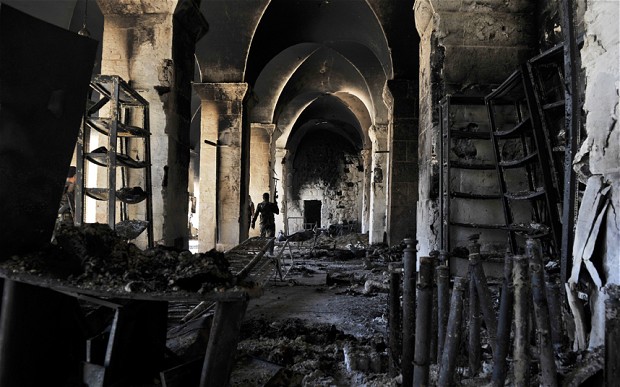Syria Feature: The Lesson of the Destruction of the Ummayad Mosque (Hanano)
 Sunday, April 28, 2013 at 8:07 |
Sunday, April 28, 2013 at 8:07 |  Scott Lucas in
Scott Lucas in  EA Live,
EA Live,  EA Middle East and Turkey,
EA Middle East and Turkey,  Middle East and Iran
Middle East and Iran  Photo: Tauseef Mustafa/AFPLast week Aleppo's historic Ummayad Mosque, dating to the 8th century, was ruined and its minaret toppled by fighting. Amal Hanano offers her thoughts on Syria Deeply:
Photo: Tauseef Mustafa/AFPLast week Aleppo's historic Ummayad Mosque, dating to the 8th century, was ruined and its minaret toppled by fighting. Amal Hanano offers her thoughts on Syria Deeply:
I still remember how it smells, musty and old. It smelled like the air has never changed for centuries. The 1,000-year-old stone, worn rugs and stacked holy books were timeless. I remember how it was peaceful inside. No matter how hot it was outside, it was cool inside the vaulted rooms. A calm world tucked within a world filled with noise, dust and now chaos.
I remember how we would go sometimes to pray and other times with visitors. We would drape the long black abayas over our street clothes and cover our hair. We would laugh and take pictures of each other in the courtyard while old men recited verses in a corner and pigeons flew under the arches. It was a place to connect to your history, to your identity and to tell others, who were not from Aleppo: “This is where we are from. This is who we are.” This is where you come to face your roots. It was a place that existed forever, a place we thought would exist long after we were gone. But we were wrong.
They say that people make their cities. But if you are from Aleppo, one of the oldest cities in the world, the city has made you much more than you have made it. So when pieces of our history are destroyed one by one, pieces of us are lost, fragment by fragment.
***
We really don’t know [whether Umayyad was targeted on purpose]. The story of the regime is that the jihadists blew it up on purpose, and the story of the Free Syrian Army is that it was under regime control and the regime had planted explosives within the mosque, and then the regime blew it up. It’s highly unlikely that the rebels or Jabhat al-Nusra would explode the minaret. Jabhat would not do that to a mosque. It was probably either targeted by the regime or fell as a result of crossfire.
It’s so sad and it’s so old. It’s 960 years old. And the mosque itself was built in the 8th century. The site, the ground, went back to Hellenistic times, then in Christianity it was a church. All of the Old City of Aleppo is like that, layers of history built on top of each other.
Mosque minarets were really used as urban planning devices.
They planned the streets around that mosque to center around the minaret, so that the minaret would be in center of your [vantage point].
It’s very symbolic. People are really devastated. A lot of people changed their picture on social media to show the minaret. Or rather, a broken minaret. It’s part of our identity. The BBC got backlash for heavily covering it, because people said, ‘Why are you covering the destruction of a minaret when so many people are dying?’ But there is that sense that it’s part of our identity, and people are mourning it.
People in Aleppo are extremely proud of their architecture, especially our minaret. It’s a big sense of pride for people from Aleppo. And this is the most important site in the city, after the citadel.
***
"The minarets, like trees, have souls." –-- Nizar Qabbani
The lesson of the minaret: every tyrant will fall and the city remains. History has taught us that the people find a way to pick up the pieces of their city and rebuild. One thousand years from now, these years will be a chapter in history books. The future people of Aleppo will visit this sacred site and will feel the calm and peace once more. The stone will be old again. They will point to the square tower and whisper to their children the tale of this minaret that falls every few centuries when the lesson of tyranny must be taught to a people who had forgotten. Those people of the future are lucky. They will be unaware of the pain of living those years, unaware of the shame of writing this chapter. History is abstract and seamless to them, like it once was for us. It is merely a story they can recite while they trace their fingers over the stone and remember without consequence. I envy them.
 Aleppo,
Aleppo,  Amal Hanano,
Amal Hanano,  Nizar Qabbani,
Nizar Qabbani,  Syria,
Syria,  Syria Deeply,
Syria Deeply,  Ummayad Mosque
Ummayad Mosque 
Reader Comments